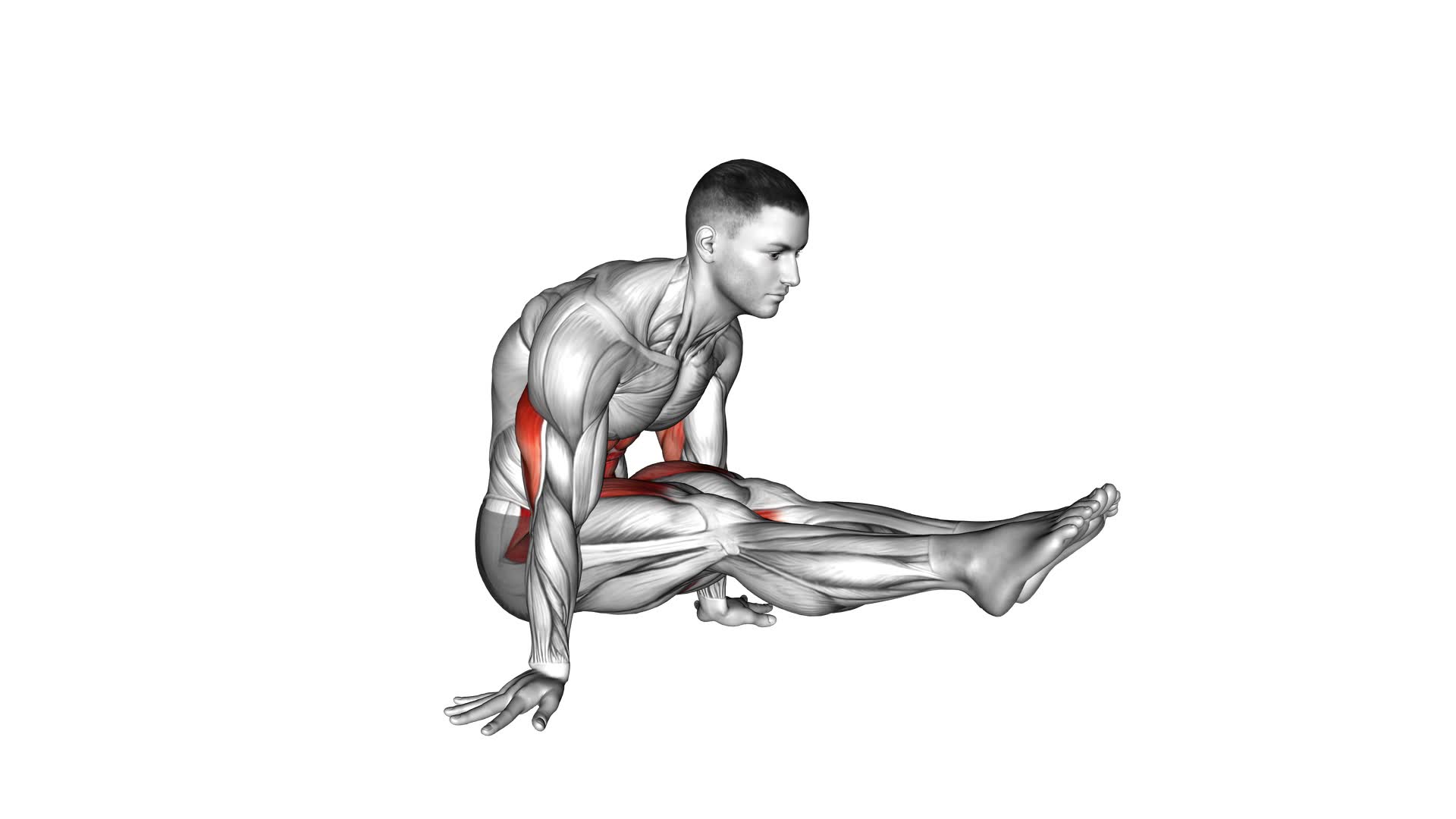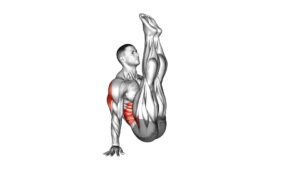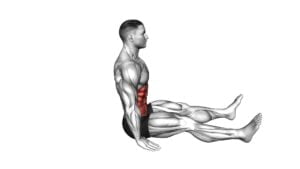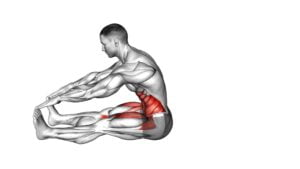L-Sit on Floor – Video Exercise Guide & Tips

Get ready to strengthen your core and build impressive upper body strength with the L-Sit on the floor!
Watch This Exercise Video
In this video exercise guide, we'll show you the proper form and technique to master this challenging move. Discover the benefits of incorporating the L-Sit into your routine, common mistakes to avoid, and helpful progressions and variations.
Plus, we'll share tips for increasing flexibility and a sample L-Sit workout routine to get you started.
Let's get those abs burning!
Key Takeaways
- The L-Sit targets multiple muscle groups, including the abs, hip flexors, and quads.
- Proper form and technique, such as engaging the core and maintaining parallel legs, are important for maximizing the benefits of the L-Sit.
- Common mistakes to avoid include not engaging the core enough, allowing the shoulders to round forward, and letting the legs drop too low.
- There are progressions and variations of the L-Sit that can be used to gradually increase difficulty and challenge different muscle groups.
Benefits of the L-Sit
You should regularly practice the L-Sit exercise to experience the numerous benefits it offers.
One of the main benefits of the L-Sit is muscle activation. This exercise targets multiple muscle groups, including your abs, hip flexors, and quads. By holding your body in a static position, you engage these muscles and strengthen them over time.
Another significant benefit of the L-Sit is its ability to improve core strength. Your core muscles are essential for maintaining balance and stability in your body. The L-Sit challenges your core by requiring you to lift your legs off the floor and hold them parallel to the ground. This exercise forces your core muscles to work hard to keep your body in the correct position.
In addition to muscle activation and core strength, the L-Sit also helps improve overall body control and flexibility. As you practice this exercise, you'll notice increased coordination and control over your body movements. Furthermore, the L-Sit stretches your hamstrings and hip flexors, enhancing your flexibility.
Proper Form and Technique
To maintain proper form and technique during the L-Sit exercise, it's crucial to focus on engaging your core muscles and lifting your legs off the floor parallel to the ground. By following these guidelines, you can ensure that you perform the exercise correctly and reap the benefits of proper form:
- Engage your core: Your core muscles play a key role in stabilizing your body during the L-Sit. Focus on contracting your abs and lower back muscles to keep your body stable and balanced.
- Lift your legs parallel to the ground: The goal of the L-Sit is to lift your legs off the floor and hold them parallel to the ground. This requires strength and flexibility in your hip flexors and hamstrings. Keep your legs straight and avoid bending at the knees to maintain proper form.
By maintaining proper form and technique during the L-Sit exercise, you can maximize its benefits. Proper form ensures that you're engaging the right muscles and working them effectively. Technique is crucial for avoiding injury and getting the most out of the exercise.
Now that you understand the importance of proper form and technique, let's move on to the next section where we'll discuss common mistakes to avoid.
Common Mistakes to Avoid
Maintaining proper form and technique during the L-Sit exercise is crucial to avoid common mistakes that can hinder your progress. By being aware of these mistakes and implementing some tips for improvement, you can optimize your L-Sit training and achieve better results.
One common mistake isn't engaging your core muscles enough. To avoid this, focus on actively squeezing your abs and pulling your legs up towards your chest. This will help you maintain the correct position and maximize the effectiveness of the exercise.
Another mistake is allowing your shoulders to round forward. This can lead to poor form and decreased stability. To correct this, keep your shoulders down and back, and imagine pressing them into the floor. This will help you maintain proper alignment and prevent unnecessary strain on your shoulders.
Additionally, some people tend to let their legs drop too low during the L-Sit. To avoid this, focus on keeping your legs parallel to the floor. If you find it challenging, you can start by bending your knees slightly until you build enough strength to straighten your legs.
By being mindful of these common mistakes and implementing the tips for improvement, you can enhance your L-Sit exercise and progress towards more advanced variations.
Now, let's explore some progressions and variations that can take your L-Sit training to the next level.
Progressions and Variations
Once you have mastered the basic L-Sit on the floor, you can begin exploring progressions and variations to challenge yourself further. Here are some progressions and modifications to consider:
- Progressions:
- Tuck L-Sit: Start by lifting your feet off the ground and bending your knees towards your chest. This decreases the leverage and makes the exercise more challenging.
- One-Leg L-Sit: Lift one leg off the ground while keeping the other leg extended. This increases the demand on your core and hip flexors.
- Modifications:
- L-Sit with Support: Place your hands on blocks or parallettes to elevate your body. This decreases the demand on your core and allows you to focus on building strength in your arms and shoulders.
- L-Sit on Dip Bars: Perform the L-Sit on parallel bars or dip bars. This increases the stability challenge and engages more muscles in your upper body.
Remember to progress gradually and only move on to more challenging variations once you have mastered the previous one. Experiment with different progressions and modifications to find what works best for your current fitness level and goals.
Keep pushing yourself and enjoy the journey of improving your L-Sit on the floor.
Tips for Increasing Flexibility
If you want to increase your flexibility, there are a few key tips you should keep in mind.
First, incorporating dynamic stretching techniques into your routine can help improve range of motion and warm up your muscles.
Additionally, regular stretching can have numerous benefits, such as reducing muscle soreness, improving posture, and enhancing athletic performance.
Dynamic Stretching Techniques
Increase your flexibility with dynamic stretching techniques.
Dynamic stretching plays a crucial role in injury prevention and is an important part of warm-up exercises. Here are two reasons why incorporating dynamic stretching into your routine is beneficial:
- Enhances muscle performance: Dynamic stretching helps to increase blood flow and oxygen delivery to your muscles, preparing them for the upcoming physical activity. This, in turn, improves muscle performance and reduces the risk of muscle strains and tears.
- Improves joint range of motion: Dynamic stretching involves moving your body through a full range of motion, which helps to increase the flexibility of your joints. This increased range of motion allows for better movement efficiency and reduces the likelihood of joint injuries.
Benefits of Regular Stretching
To maximize the benefits of dynamic stretching, incorporate regular stretching into your routine to further increase flexibility and prevent injuries.
Regular stretching plays a crucial role in improving flexibility and overall athletic performance. By stretching regularly, you can increase the range of motion in your joints, allowing for better movement and reduced muscle stiffness.
Stretching also helps improve blood circulation to the muscles, which promotes faster recovery and reduces muscle soreness after workouts. Additionally, stretching helps to maintain muscle balance and prevent muscular imbalances that can lead to injuries.
It's important to note that stretching should be done properly and not be rushed. Take your time and focus on each stretch, holding it for at least 30 seconds to get the full benefits.
Incorporating regular stretching into your routine is essential for improving flexibility and preventing injuries, so make sure to make it a priority in your fitness regimen.
Sample L-Sit Workout Routine
Now that you've learned the proper form techniques for the L-Sit on the floor, it's time to put them into action with a sample workout routine.
This routine will include progression options for beginners, allowing you to gradually build strength and stamina.
Additionally, we'll discuss how to incorporate L-Sits into your existing workout routines, maximizing their benefits and helping you achieve your fitness goals.
Proper Form Techniques
Start by positioning yourself in a seated position on the floor, with your legs extended straight in front of you. To achieve proper form for the L-Sit exercise, follow these techniques:
- Engage your core by pulling your belly button towards your spine.
- Press your hands into the ground and lift your body off the floor, keeping your legs straight.
- Point your toes and push through your heels to maintain a strong body alignment.
By practicing these proper form techniques, you'll improve your core strength, which is crucial for performing the L-Sit.
Remember to start with L sit progressions that suit your current fitness level and gradually increase the difficulty as you get stronger.
Now, let's explore progression options for beginners.
Progression Options for Beginners
You can begin your L-Sit workout routine as a beginner by focusing on progression options. L-Sit progressions are a great way to build strength and improve your ability to hold the L-Sit position.
Start by practicing the tuck L-Sit, where you sit on the floor with your knees bent and lift your feet off the ground. Gradually work towards extending your legs and straightening them out in front of you to achieve the full L-Sit position.
Another beginner exercise is the supported L-Sit, where you use parallel bars or dip bars to assist in holding the position. As you progress, you can decrease the amount of assistance until you're able to do a full L-Sit on the floor.
Remember to practice consistently and gradually increase the difficulty of your exercises to continue challenging yourself.
Incorporating L-Sits Into Existing Workout Routines
To incorporate L-Sits into your existing workout routine, continue building upon your progressions and gradually integrate them into your exercises. Here are some tips to help you incorporate L-Sits effectively:
- L-Sit Modifications for Advanced Athletes:
- Straddle L-Sit: Instead of keeping your legs straight in front of you, spread them apart in a straddle position.
- V-Sit: Lift both your legs and upper body off the ground, forming a V shape with your body.
- Combining L-Sits with Other Core Exercises:
- L-Sit to Tuck Hold: Transition from an L-Sit to a tuck hold by bringing your knees towards your chest.
- L-Sit Leg Raises: While in an L-Sit position, raise your legs up and down, engaging your core muscles.
Frequently Asked Questions
How Long Does It Take to Master the L-Sit Exercise?
To master the L-sit exercise, it takes time and practice. Start with L-sit exercise progressions like knee tucks and hanging leg raises.
Avoid common mistakes such as rounding your lower back or not engaging your core.
Focus on building strength in your abs, hip flexors, and shoulders.
Consistency is key, so keep working on it and you'll see progress over time.
Don't get discouraged, just keep pushing yourself!
Can the L-Sit Exercise Be Modified for Beginners?
Yes, the L-sit exercise can be modified for beginners.
There are modified L-sit variations and L-sit progressions that can help you build the strength and stability needed to eventually perform the full L-sit.
These variations may involve bending the knees or using support from your hands or a bench.
Are There Any Specific Muscle Groups That the L-Sit Targets?
The L-sit exercise targets several specific muscle groups in your body. It primarily works your core muscles, including your abs and obliques, to help strengthen and stabilize your midsection.
It also engages your hip flexors, which are responsible for lifting your legs in the L-shape position.
Additionally, the L-sit targets your triceps, as you need to push down on the floor to lift your body off the ground.
Incorporating the L-sit into your regular workout routine can provide numerous benefits.
What Are Some Alternatives to the L-Sit for Core Strength Training?
Looking to strengthen your core without the L-Sit? There are plenty of alternatives to try.
Plank variations are a great option, as they engage your core muscles and build stability.
You can also incorporate hanging leg raises, which target your lower abs and hip flexors.
These exercises will help you develop a strong core and improve your overall fitness.
Give them a try and see the results for yourself!
Can the L-Sit Exercise Help Improve Posture?
The L-Sit exercise can be beneficial for improving posture. By engaging your core muscles, the L-Sit helps to strengthen and stabilize your spine, promoting better spinal alignment. This can alleviate back pain and improve your overall posture.
Incorporating the L-Sit into your workout routine can provide a challenging yet effective way to target your core muscles and improve your posture. Remember to maintain proper form and consult with a fitness professional if you have any concerns.
Conclusion
In conclusion, the L-Sit is a challenging exercise that offers numerous benefits, including improved core strength and flexibility.
By maintaining proper form and technique, avoiding common mistakes, and incorporating progressions and variations, you can make the most out of your L-Sit workout routine.
With dedication and consistency, you can gradually increase your flexibility and achieve impressive results.
So, why not give the L-Sit a try and take your fitness to the next level?

Author
Years ago, the spark of my life’s passion ignited in my mind the moment I stepped into the local gym for the first time. The inaugural bead of perspiration, the initial endeavor, the very first surge of endorphins, and a sense of pride that washed over me post-workout marked the beginning of my deep-seated interest in strength sports, fitness, and sports nutrition. This very curiosity blossomed rapidly into a profound fascination, propelling me to earn a Master’s degree in Physical Education from the Academy of Physical Education in Krakow, followed by a Sports Manager diploma from the Jagiellonian University. My journey of growth led me to gain more specialized qualifications, such as being a certified personal trainer with a focus on sports dietetics, a lifeguard, and an instructor for wellness and corrective gymnastics. Theoretical knowledge paired seamlessly with practical experience, reinforcing my belief that the transformation of individuals under my guidance was also a reflection of my personal growth. This belief holds true even today. Each day, I strive to push the boundaries and explore new realms. These realms gently elevate me to greater heights. The unique combination of passion for my field and the continuous quest for growth fuels my drive to break new ground.



